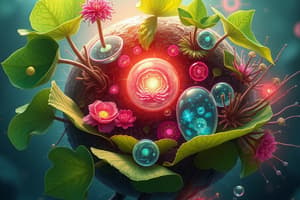Podcast
Questions and Answers
Chlorophyll absorbs green and yellow light during the light-dependent reactions of photosynthesis.
Chlorophyll absorbs green and yellow light during the light-dependent reactions of photosynthesis.
False (B)
The light-independent reactions of photosynthesis are also known as the Krebs cycle.
The light-independent reactions of photosynthesis are also known as the Krebs cycle.
False (B)
Water molecules in photosynthesis are split into oxygen, hydrogen ions, and electrons during the light-independent reactions.
Water molecules in photosynthesis are split into oxygen, hydrogen ions, and electrons during the light-independent reactions.
False (B)
The Calvin cycle occurs in the thylakoid membranes of chloroplasts.
The Calvin cycle occurs in the thylakoid membranes of chloroplasts.
Phycobilins are not involved in the light-dependent reactions of photosynthesis.
Phycobilins are not involved in the light-dependent reactions of photosynthesis.
During photosynthesis, electrons released from water molecules are used to produce ATP.
During photosynthesis, electrons released from water molecules are used to produce ATP.
The final electron acceptor in photosynthesis is NADPH.
The final electron acceptor in photosynthesis is NADPH.
The Calvin cycle occurs in the thylakoid membrane of the chloroplast.
The Calvin cycle occurs in the thylakoid membrane of the chloroplast.
Rubisco enzyme converts CO2 into a stable five-carbon compound called RuBP.
Rubisco enzyme converts CO2 into a stable five-carbon compound called RuBP.
Glyceraldehydes-3-phosphate (G3P) can only be regenerated back into RuBP in the Calvin cycle.
Glyceraldehydes-3-phosphate (G3P) can only be regenerated back into RuBP in the Calvin cycle.
ATP and NADP+ are used to produce another molecule of RuBP during the Calvin cycle.
ATP and NADP+ are used to produce another molecule of RuBP during the Calvin cycle.
Photosynthetic organisms have no impact on shaping Earth's atmosphere.
Photosynthetic organisms have no impact on shaping Earth's atmosphere.
Flashcards are hidden until you start studying
Study Notes
Photosynthesis: Harnessing Sunlight to Create Life's Building Blocks
Photosynthesis is one of nature's most essential processes. It's the natural process by which plants, algae, and some bacteria convert sunlight into chemical energy in the form of glucose – a sugar we all need to survive. At its core, photosynthesis involves two main stages: the light-dependent reactions, which occur in chloroplasts; and the light-independent reactions, also known as the Calvin cycle, which take place in the stroma. Let's dive deeper into these intricate processes.
Light-Dependent Reactions
The first stage of photosynthesis, the light-dependent reactions, occurs within thylakoid membranes located inside chloroplasts. These reactions involve three primary pigments: chlorophyll, carotenoids, and phycobilins. When sunlight hits these pigments, it creates excited electrons that initiate a series of reactions, ultimately producing ATP and NADPH.
- Light Absorption: Chlorophyll absorbs blue and red light while carotenoids absorb green light. This selective absorption allows for efficient transfer of energy from light to the molecule.
- Water Splitting: Water molecules are split into oxygen, hydrogen ions, and electrons. The oxygen is released as a waste product, while the electrons are used in the electron transport chain.
- Electron Transport Chain: These electrons are passed along a chain of proteins, each releasing some of their energy in the form of ATP. The final electron acceptor is NADP+, which is converted into NADPH.
Light-Independent Reactions
The second stage of photosynthesis, the Calvin cycle, occurs in the stroma of the chloroplast. This process is also known as CO2 fixation. It involves a set of enzymes that convert carbon dioxide (CO2) into glucose (C6H12O6) using energy from ATP and NADPH produced during the light-dependent reactions.
- Carbon Fixation: The enzyme Rubisco captures CO2 and forms unstable six-carbon compound, which is quickly converted into a more stable five-carbon compound called ribulose bisphosphate(RuBP).
- Reduction: Two molecules of RuBP are split into two molecules of glyceraldehydes-3-phosphate (G3P) through several enzymatic steps. G3P can either be used immediately to make other organic molecules or regenerated back into RuBP to fix more CO2.
- Regeneration: ATP and NADPH generated during the light-dependent reactions are used to produce another molecule of RuBP, allowing the cycle to continue.
Importance of Photosynthesis
Throughout its evolutionary history, photosynthetic organisms have played key roles in shaping our planet. They are responsible for creating oxygen in Earth's atmosphere, contributing to climate regulation, and providing habitats for countless species. Furthermore, they release valuable materials like tannin, saponin, resin, rubber, and phenol, which humans utilize in various industrial applications.
In summary, photosynthesis is a fascinating process that harnesses sunlight to create life's building blocks. While we might never fully grasp its complexity, understanding this fundamental mechanism deepens our appreciation for the world around us and paves the way for future discoveries.
Studying That Suits You
Use AI to generate personalized quizzes and flashcards to suit your learning preferences.




